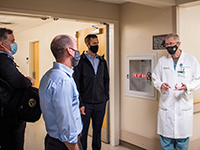 Last month, UAB was the meeting place for a global gathering of Air Force Rescue personnel. Hosted by the Division of Trauma and Acute Care Surgery, the Pararescue Medical Operations Advisory Board meeting is held annually to discuss the progress and future of the medical training aspect of the Air Force Pararescuemen, or PJs as they’re commonly known.
Last month, UAB was the meeting place for a global gathering of Air Force Rescue personnel. Hosted by the Division of Trauma and Acute Care Surgery, the Pararescue Medical Operations Advisory Board meeting is held annually to discuss the progress and future of the medical training aspect of the Air Force Pararescuemen, or PJs as they’re commonly known.
PJs are Special Warfare airmen who perform rescue and recovery missions for service members, foreign partners, and civilians in the most dangerous settings and austere environments across the globe. They’re trained to jump out of airplanes, dive, and even snowmobile so they can navigate any terrain. PJs are called upon to save lives not just in combat situations but in humanitarian crises and natural disasters as well. PJs were heavily involved in the successful rescue of 12 boys and their soccer coach during the multinational Thai Cave Rescue in 2018. Additionally, PJs serve as the recovery support for NASA astronauts after a water landing. As the first medical response in critical situations, they must be able to resuscitate and stabilize the seriously injured.
The event included “mission vignettes” – real world stories from the past year told by the PJs involved, including a successful mission to stabilize and rescue a civilian mariner experiencing symptoms of a heart attack 500 nautical miles off the coast of Kenya in the Indian Ocean.
Historically, the medical training for the PJs hasn’t been as extensive as the other necessary, and impressive, technical skills the PJs need to be proficient in, like parachuting and diving. PJs must recertify their paramedic training every two years, but this can be done at locations across the country, leading to significant skillset variability across the PJs.
Since 2006, the Division of Trauma and Acute Care Surgery has hosted PJs at UAB for two-week rotations where they’re fully clinically integrated, getting hands-on experience like putting in IVs and chest tubes, performing operating room intubations, and assessing, triaging, and managing trauma patients. Individual military units have independently decided to come to UAB – it wasn’t a mandatory requirement.
Colonel John Dorsch, wing surgeon and the physician and medical officer for the 24th Special Operations Wing, under Air Force Special Operations Command, began regularly visiting UAB in 2018 and saw the potential to expand the PJ program and standardize these rotations into a formal course – by utilizing UAB as a central training hub.
The longstanding partnership between UAB and the Air Force, which also includes the Special Operations Surgical Teams stationed at UAB, has led to the 2020 launch of the Special Operations Center for Medical Integration and Development (SOCMID) housed at UAB. SOCMID is that hub Dorsch envisioned.
The first formal course for PJs was in November of 2020. Units are strongly encouraged to attend the course, and plans for the future are to make it mandatory.
“For PJs to be clinically sharp when they get to where they’re going is so vital – and UAB can provide us that,” Dorsch said.
At the meeting, Associate Professor Dr. Daniel Cox, M.D., UAB’s Chief of Trauma Service, presented on how UAB’s high trauma volume gives PJs ample opportunities to hone their skills and see the types of penetrating injuries they may see in combat. Cox also highlighted the unique presence of veteran and active duty surgeons at UAB, noting he had personally received patients from the PJs when he was deployed in Afghanistan.
“As a visiting PJ, you are learning from someone that understands your environment and the challenges that it presents,” Cox said. “We’re speaking the same language. The PJs are working alongside medical professionals and faculty with deployment experience who can help make training more relevant to these guys and what they do in the deployed environment.”
One such faculty member, Professor John Holcomb, M.D., FACS, a renowned researcher and veteran military surgeon who operated on the wounded during the Battle of Mogadishu, and whom Cox describes as the “godfather of current military trauma,” gave the keynote address and spoke about the evolution of combat medicine and how it has informed innovation in trauma care.
Over 200 people attended the event either in-person or remotely while deployed across the world. In-person attendees received a tour of UAB’s Trauma Bay, Trauma/Burn ICU, and the SOCMID office, including the chance to put on a virtual reality headset and experience the simulation piece of the PJ’s training. The scenario attendees were dropped into? Caring for a critically injured patient on an aircraft by checking vitals, inserting a chest tube, and applying tourniquets.
“It was an honor for UAB and the Division of Trauma and Acute Care Surgery to host the PJ Medical Officer Advisory Board,” said Cox. “It provided a great setting for the Pararescue career field to review their many successes of the last year and focus on how to prepare for future challenges. Being on site at UAB highlighted the success and further potential of the SOCMID program at UAB and we look forward to continuing to support the PJ’s clinical sustainment and growth in the years to come.”
